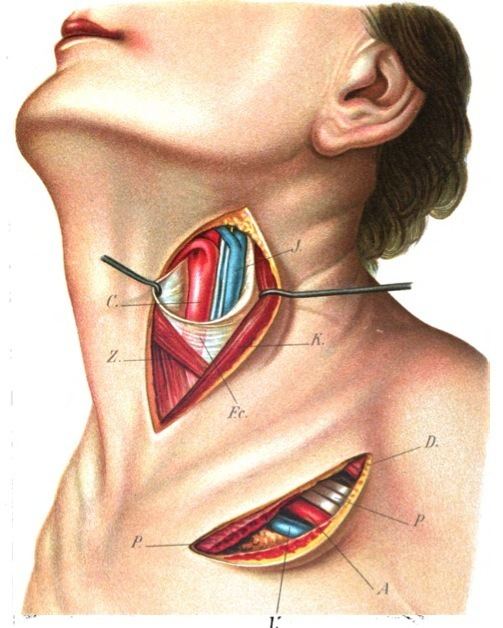Vein superior thyroid vein Dorlands/Elsevier a_61/12156385 | Supplies thyroid | |
 | ||
Branches Hyoid arterySternocleidomastoid arterySuperior laryngeal arteryCricothyroid artery Latin Arteria thyreoidea superior | ||
The superior thyroid artery arises from the external carotid artery just below the level of the greater cornu of the hyoid bone and ends in the thyroid gland.
Contents
Structure
From its origin under the anterior border of the sternocleidomastoid the superior thyroid artery runs upward and forward for a short distance in the carotid triangle, where it is covered by the skin, platysma, and fascia; it then arches downward beneath the omohyoid, sternohyoid, and sternothyroid muscles.
To its medial side are the inferior pharyngeal constrictor muscle and the external branch of the superior laryngeal nerve.
Branches
It distributes twigs to the adjacent muscles, and numerous branches to the thyroid gland, connecting with its fellow of the opposite side, and with the inferior thyroid arteries. The branches to the gland are generally two in number. One, the larger, supplies principally the anterior surface; on the isthmus of the gland it connects with the corresponding artery of the opposite side. A second branch descends on the posterior surface of the gland and anastomoses with the inferior thyroid artery.
Besides the arteries distributed to the muscles and to the thyroid gland, the branches of the superior thyroid are:
Clinical significance
This artery must be ligated at the thyroid when conducting a thyroidectomy. If the artery is severed, but not ligated, it will bleed profusely. In order to gain control of the bleeding, the surgeon may need to extend the original incision laterally to ligate the artery at its origin at the external carotid artery. Furthermore, the external laryngeal branch of the superior laryngeal nerve courses in close proximity to the superior thyroid artery, making it at risk for injury during surgery.
